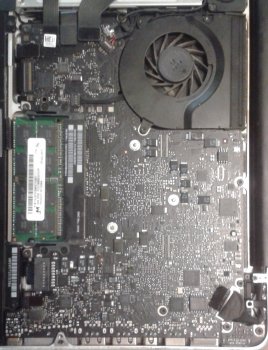Hi all,
I have a "MacBook Pro (13-inch, Mid 2012)", which has had coffee spilled over its keyboard and air-vent. As soon as that happened, I shut it down, opened it up and unplugged the battery. Took it all to pieces as much as possible, dabbed up all the liquid I could see, then left the machine in pieces and all components inside a sealed bag with a load of rice for about 72 hours.
Now, having assembled everything again:
-> the power button doesn't work (can't turn the machine on).
However, when I disconnect the battery, then reconnect it, a few seconds later, the laptop does power up, with:
-> fan spinning at full speed.
-> battery indicator "crossed-out" and says no battery is present.
-> iStat and System Profile also report no battery.
-> iStat sees no temperature sensors either.
All that sounds "SMC" related to me. I have attempted a SMC reset, to no effect. I have an identical battery which I tried in and observed no change. I have tried disconnecting the battery and holding the power button for a long time, no effect. I have inspected the logic-board for any rust, corrosion, liquid and cleaned with alcohol anything I thought looked suspicious.
I'm at a loss here. I wonder if anything can still be done or if some component in the SMC is dead. I'd love to have some help if anybody has any more troubleshooting steps I can try.
The picture shows the logic board.
EMC No.: 2419
MLB NO.: C02132700AWDRKQA4
Thanks in advance.
Best regards.
Mark.
PS: I have had a cursory look at this thread https://forums.macrumors.com/threads/smc-issue-on-mbp-13-hardware-troubleshooting-guide.1122338/ but I can't get the laptop to power up with the "trick" indicated there in the first post, that uses the magsafe, and it is not quite the same model so I'm not sure how much help the information there should be anyway. The pictures of the logic board clearly don't match up with mine.
I have a "MacBook Pro (13-inch, Mid 2012)", which has had coffee spilled over its keyboard and air-vent. As soon as that happened, I shut it down, opened it up and unplugged the battery. Took it all to pieces as much as possible, dabbed up all the liquid I could see, then left the machine in pieces and all components inside a sealed bag with a load of rice for about 72 hours.
Now, having assembled everything again:
-> the power button doesn't work (can't turn the machine on).
However, when I disconnect the battery, then reconnect it, a few seconds later, the laptop does power up, with:
-> fan spinning at full speed.
-> battery indicator "crossed-out" and says no battery is present.
-> iStat and System Profile also report no battery.
-> iStat sees no temperature sensors either.
All that sounds "SMC" related to me. I have attempted a SMC reset, to no effect. I have an identical battery which I tried in and observed no change. I have tried disconnecting the battery and holding the power button for a long time, no effect. I have inspected the logic-board for any rust, corrosion, liquid and cleaned with alcohol anything I thought looked suspicious.
I'm at a loss here. I wonder if anything can still be done or if some component in the SMC is dead. I'd love to have some help if anybody has any more troubleshooting steps I can try.
The picture shows the logic board.
EMC No.: 2419
MLB NO.: C02132700AWDRKQA4
Thanks in advance.
Best regards.
Mark.
PS: I have had a cursory look at this thread https://forums.macrumors.com/threads/smc-issue-on-mbp-13-hardware-troubleshooting-guide.1122338/ but I can't get the laptop to power up with the "trick" indicated there in the first post, that uses the magsafe, and it is not quite the same model so I'm not sure how much help the information there should be anyway. The pictures of the logic board clearly don't match up with mine.


